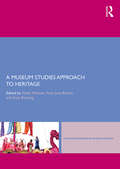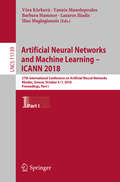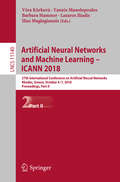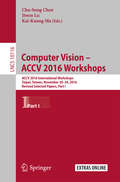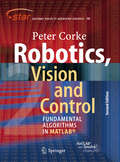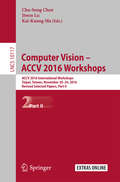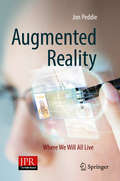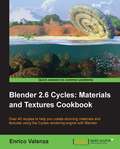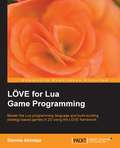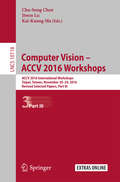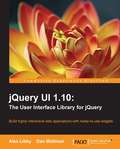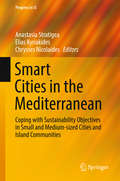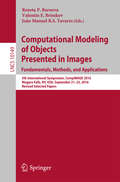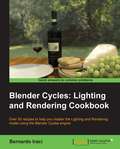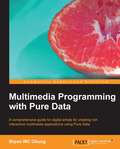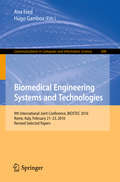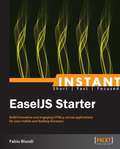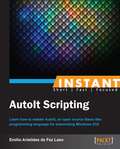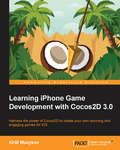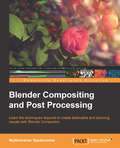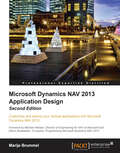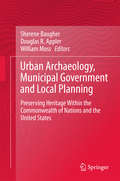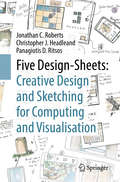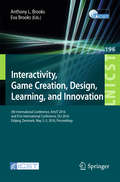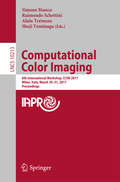- Table View
- List View
A Museum Studies Approach to Heritage (Leicester Readers in Museum Studies)
by Sheila Watson Amy Jane Barnes Katy BunningHeritage’s revival as a respected academic subject has, in part, resulted from an increased awareness and understanding of indigenous rights and non-Western philosophies and practices, and a growing respect for the intangible. Heritage has, thus far, focused on management, tourism and the traditionally ‘heritage-minded’ disciplines, such as archaeology, geography, and social and cultural theory. Widening the scope of international heritage studies, A Museum Studies Approach to Heritage explores heritage through new areas of knowledge, including emotion and affect, the politics of dissent, migration, and intercultural and participatory dimensions of heritage. Drawing on a range of disciplines and the best from established sources, the book includes writing not typically recognised as 'heritage', but which, nevertheless, makes a valuable contribution to the debate about what heritage is, what it can do, and how it works and for whom. Including heritage perspectives from beyond the professional sphere, the book serves as a reminder that heritage is not just an academic concern, but a deeply felt and keenly valued public and private practice. This blending of traditional topics and emerging trends, established theory and concepts from other disciplines offers readers international views of the past and future of this growing field. A Museum Studies Approach to Heritage offers a wider, more current and more inclusive overview of issues and practices in heritage and its intersection with museums. As such, the book will be essential reading for postgraduate students of heritage and museum studies. It will also be of great interest to academics, practitioners and anyone else who is interested in how we conceptualise and use the past.
Artificial Neural Networks and Machine Learning – ICANN 2018: 27th International Conference on Artificial Neural Networks, Rhodes, Greece, October 4-7, 2018, Proceedings, Part I (Lecture Notes in Computer Science #11139)
by Věra Kůrková Yannis Manolopoulos Barbara Hammer Lazaros Iliadis Ilias MaglogiannisThis three-volume set LNCS 11139-11141 constitutes the refereed proceedings of the 27th International Conference on Artificial Neural Networks, ICANN 2018, held in Rhodes, Greece, in October 2018. The papers presented in these volumes was carefully reviewed and selected from total of 360 submissions. They are related to the following thematic topics: AI and Bioinformatics, Bayesian and Echo State Networks, Brain Inspired Computing, Chaotic Complex Models, Clustering, Mining, Exploratory Analysis, Coding Architectures, Complex Firing Patterns, Convolutional Neural Networks, Deep Learning (DL), DL in Real Time Systems, DL and Big Data Analytics, DL and Big Data, DL and Forensics, DL and Cybersecurity, DL and Social Networks, Evolving Systems – Optimization, Extreme Learning Machines, From Neurons to Neuromorphism, From Sensation to Perception, From Single Neurons to Networks, Fuzzy Modeling, Hierarchical ANN, Inference and Recognition, Information and Optimization, Interacting with The Brain, Machine Learning (ML), ML for Bio Medical systems, ML and Video-Image Processing, ML and Forensics, ML and Cybersecurity, ML and Social Media, ML in Engineering, Movement and Motion Detection, Multilayer Perceptrons and Kernel Networks, Natural Language, Object and Face Recognition, Recurrent Neural Networks and Reservoir Computing, Reinforcement Learning, Reservoir Computing, Self-Organizing Maps, Spiking Dynamics/Spiking ANN, Support Vector Machines, Swarm Intelligence and Decision-Making, Text Mining, Theoretical Neural Computation, Time Series and Forecasting, Training and Learning.
Artificial Neural Networks and Machine Learning – ICANN 2018: 27th International Conference on Artificial Neural Networks, Rhodes, Greece, October 4-7, 2018, Proceedings, Part II (Lecture Notes in Computer Science #11140)
by Věra Kůrková Yannis Manolopoulos Barbara Hammer Lazaros Iliadis Ilias MaglogiannisThis three-volume set LNCS 11139-11141 constitutes the refereed proceedings of the 27th International Conference on Artificial Neural Networks, ICANN 2018, held in Rhodes, Greece, in October 2018. The 139 full and 28 short papers as well as 41 full poster papers and 41 short poster papers presented in these volumes was carefully reviewed and selected from total of 360 submissions. They are related to the following thematic topics: AI and Bioinformatics, Bayesian and Echo State Networks, Brain Inspired Computing, Chaotic Complex Models, Clustering, Mining, Exploratory Analysis, Coding Architectures, Complex Firing Patterns, Convolutional Neural Networks, Deep Learning (DL), DL in Real Time Systems, DL and Big Data Analytics, DL and Big Data, DL and Forensics, DL and Cybersecurity, DL and Social Networks, Evolving Systems – Optimization, Extreme Learning Machines, From Neurons to Neuromorphism, From Sensation to Perception, From Single Neurons to Networks, Fuzzy Modeling, Hierarchical ANN, Inference and Recognition, Information and Optimization, Interacting with The Brain, Machine Learning (ML), ML for Bio Medical systems, ML and Video-Image Processing, ML and Forensics, ML and Cybersecurity, ML and Social Media, ML in Engineering, Movement and Motion Detection, Multilayer Perceptrons and Kernel Networks, Natural Language, Object and Face Recognition, Recurrent Neural Networks and Reservoir Computing, Reinforcement Learning, Reservoir Computing, Self-Organizing Maps, Spiking Dynamics/Spiking ANN, Support Vector Machines, Swarm Intelligence and Decision-Making, Text Mining, Theoretical Neural Computation, Time Series and Forecasting, Training and Learning.
Computer Vision – ACCV 2016 Workshops: ACCV 2016 International Workshops, Taipei, Taiwan, November 20-24, 2016, Revised Selected Papers, Part I (Lecture Notes in Computer Science #10116)
by Chu-Song Chen Jiwen Lu Kai-Kuang MaThe three-volume set, consisting of LNCS 10116, 10117, and 10118, contains carefully reviewed and selected papers presented at 17 workshops held in conjunction with the 13th Asian Conference on Computer Vision, ACCV 2016, in Taipei, Taiwan in November 2016. The 134 full papers presented were selected from 223 submissions. LNCS 10116 contains the papers selected
Robotics, Vision and Control: Fundamental Algorithms In MATLAB® Second, Completely Revised, Extended And Updated Edition (Springer Tracts in Advanced Robotics #118)
by Peter CorkeRobotic vision, the combination of robotics and computer vision, involves the application of computer algorithms to data acquired from sensors. The research community has developed a large body of such algorithms but for a newcomer to the field this can be quite daunting. For over 20 years the author has maintained two open-source MATLAB® Toolboxes, one for robotics and one for vision. They provide implementations of many important algorithms and allow users to work with real problems, not just trivial examples. This book makes the fundamental algorithms of robotics, vision and control accessible to all. It weaves together theory, algorithms and examples in a narrative that covers robotics and computer vision separately and together. Using the latest versions of the Toolboxes the author shows how complex problems can be decomposed and solved using just a few simple lines of code. The topics covered are guided by real problems observed by the author over many years as a practitioner of both robotics and computer vision. It is written in an accessible but informative style, easy to read and absorb, and includes over 1000 MATLAB and Simulink® examples and over 400 figures. The book is a real walk through the fundamentals of mobile robots, arm robots. then camera models, image processing, feature extraction and multi-view geometry and finally bringing it all together with an extensive discussion of visual servo systems. This second edition is completely revised, updated and extended with coverage of Lie groups, matrix exponentials and twists; inertial navigation; differential drive robots; lattice planners; pose-graph SLAM and map making; restructured material on arm-robot kinematics and dynamics; series-elastic actuators and operational-space control; Lab color spaces; light field cameras; structured light, bundle adjustment and visual odometry; and photometric visual servoing. “An authoritative book, reaching across fields, thoughtfully conceived and brilliantly accomplished!” OUSSAMA KHATIB, Stanford
Computer Vision – ACCV 2016 Workshops: ACCV 2016 International Workshops, Taipei, Taiwan, November 20-24, 2016, Revised Selected Papers, Part II (Lecture Notes in Computer Science #10117)
by Chu-Song Chen Jiwen Lu Kai-Kuang MaThe three-volume set, consisting of LNCS 10116, 10117, and 10118, contains carefully reviewed and selected papers presented at 17 workshops held in conjunction with the 13th Asian Conference on Computer Vision, ACCV 2016, in Taipei, Taiwan in November 2016. The 134 full papers presented were selected from 223 submissions. LNCS 10116 contains the papers selected
Augmented Reality: Where We Will All Live
by Jon PeddieThis book provides an in-depth exploration of the field of augmented reality (AR) in its entirety and sets out to distinguish AR from other inter-related technologies like virtual reality (VR) and mixed reality (MR). The author presents AR from its initial philosophies and early developments, to its current technologies and its impact on our modern society, to its possible future developments; providing readers with the tools to understand issues relating to defining, building, and using our perception of what is represented in our perceived reality, and ultimately how we assimilate and react to this information. Augmented Reality: Where We Will All Live can be used as a comprehensive guide to the field of AR and provides valuable insights for technologists, marketers, business managers, educators and academics who are interested in the field of augmented reality; its concepts, history, practices and the science behind this rapidly advancing field of research and development.
Blender 2.6 Cycles: Materials And Textures Cookbook
by Enrico ValenzaWritten in a friendly, practical style this Cookbook deep-dives into a wide-array of techniques used to create realistic materials and textures.This book is perfect for you if you have used Blender before but are new to the impressive Cycles renderer. You should have some knowledge of the Blender interface, though this is not a strict requirement. If you want to create realistic, stunning materials and textures using Cycles, then this book is for you!
LOVE for Lua Game Programming
by Darmie AkinlajaThis book follows a tutorial approach with examples and step-by-step instructions to help explain the key concepts of the LOVE framework as well as everything you need to know about game development using the Lua programming language.LOVE2d for Lua Game Programming is for anyone who is interested in learning about desktop game development.
Computer Vision – ACCV 2016 Workshops: ACCV 2016 International Workshops, Taipei, Taiwan, November 20-24, 2016, Revised Selected Papers, Part III (Lecture Notes in Computer Science #10118)
by Chu-Song Chen Jiwen Lu Kai-Kuang MaThe three-volume set, consisting of LNCS 10116, 10117, and 10118, contains carefully reviewed and selected papers presented at 17 workshops held in conjunction with the 13th Asian Conference on Computer Vision, ACCV 2016, in Taipei, Taiwan in November 2016. The 134 full papers presented were selected from 223 submissions. LNCS 10116 contains the papers selected
jQuery UI 1.10: The User Interface Library For Jquery
by Alex Libby Dan WellmanThis book consists of an easy-to-follow, example-based approach that leads you step-by-step through the implementation and customization of each library component.This book is for frontend designers and developers who need to learn how to use jQuery UI quickly. To get the most out of this book, you should have a good working knowledge of HTML, CSS, and JavaScript, and should ideally be comfortable using jQuery.
Smart Cities in the Mediterranean: Coping with Sustainability Objectives in Small and Medium-sized Cities and Island Communities (Progress in IS)
by Anastasia Stratigea Elias Kyriakides Chrysses NicolaidesThis book sheds new light on the current and future challenges faced by cities, and presents approaches, options and solutions enabled by Information and Communication Technologies (ICT) in the smart city context. By focusing on sustainability objectives within a rapidly changing social, economic, environmental and technological setting, it explores a variety of planning challenges faced by contemporary cities and the power of smart city developments in terms of providing innovative tools, approaches, methodologies and technologies to help cities cope with these challenges. Key issues addressed include smart city (e-) planning and (e-)participation; smart data management to facilitate decision-making processes in cities and insular communities on a variety of topics; smart and sustainable management aspects of climate change, water scarcity, mobility, energy, infrastructure, tourism, blue growth, risk assessment; etc. The book presents current and potential pathways and applications for the evolution of smart cities and communities, taking into consideration the unique problems and opportunities emanating from their specific geographical location. The case study examples mainly concern small and medium-sized cities and communities as well as insular areas in the Mediterranean region, while also incorporating lessons learned from other parts of the world. Their focus is on the specific opportunities and threats emerging in these urban and insular environments, which are characterized by their role as globally known tourist destinations, their coastal or port character, and unique cultural resources, as well as the high rated vulnerability in very many sustainability respects (social, economic, biodiversity, urbanization, migration, poverty, etc.) to be found in the Mediterranean region at large
Computational Modeling of Objects Presented in Images. Fundamentals, Methods, and Applications: 5th International Symposium, CompIMAGE 2016, Niagara Falls, NY, USA, September 21-23, 2016, Revised Selected Papers (Lecture Notes in Computer Science #10149)
by Reneta P. Barneva Valentin E. Brimkov João Manuel TavaresThis book constitutes the refereed post-conference proceedings of the 5th International Conference on Computational Modeling of Objects Presented in Images, CompIMAGE 2016, held in Niagara Falls, NY, USA, in September 2016. The 18 revised full papers presented together with 1 invited paper were carefully reviewed and selected from 30 submissions. The papers cover the following topics: theoretical contributions and application-driven contributions.
Blender Cycles: Lighting And Rendering Cookbook
by Bernardo IraciAn in-depth guide full of step-by-step recipes to explore the concepts behind the usage of Cycles. Packed with illustrations, and lots of tips and tricks; the easy-to-understand nature of the book will help the reader understand even the most complex concepts with ease.If you are a digital artist who already knows your way around Blender, and you want to learn about the new Cycles' rendering engine, this is the book for you. Even experts will be able to pick up new tips and tricks to make the most of the rendering capabilities of Cycles.
Multimedia Programming with Pure Data
by Bryan Wc ChungA quick and comprehensive tutorial book for media designers to jump-start interactive multimedia production with computer graphics, digital audio, digital video, and interactivity, using the Pure Data graphical programming environment.An introductory book on multimedia programming for media artists/designers who like to work on interactivity in their projects, digital art/design students who like to learn the first multimedia programming technique, and audio-visual performers who like to customize their performance sets
Biomedical Engineering Systems and Technologies: 9th International Joint Conference, BIOSTEC 2016, Rome, Italy, February 21–23, 2016, Revised Selected Papers (Communications in Computer and Information Science #690)
by Ana Fred Hugo GamboaThis book constitutes the thoroughly refereed post-conference proceedings of the 9th International Joint Conference on Biomedical Engineering Systems and Technologies, BIOSTEC 2016, held in Rome, Italy, in February 2016. The 22 revised full papers presented were carefully reviewed and selected from a total of 321 submissions. The papers are organized in topical sections on biomedical electronics and devices; bioimaging; bioinformatics models, methods and algorithms; bio-inspired systems and signal processing; health informatics.
Instant EaselJS Starter
by Fabio BiondiGet to grips with a new technology, understand what it is and what it can do for you, and then get to work with the most important features and tasks.A short and precise guide to get you started with EaselJS , helping you to create some cool applications and games. EaselJS greatly simplifies application development in HTML5 Canvas using a syntax and an architecture very similar to the ActionScript 3.0 language. As a result, Flash / Flex developers will immediately feel at home but it's very easy to learn even if you've never opened Flash in your life. The book targets Web designers, animators, Digital content producers, and Flash and Flex developers. It's assumed that you will have some experience in HTML and pure JavaScript.
Instant AutoIt Scripting
by Emilio Aristides LasoFilled with practical, step-by-step instructions and clear explanations for the most important and useful tasks. This is a Packt Instant How-to guide, which provides concise and clear recipes for getting started with AutoIt.Instant AutoIt Scripting Essentials How-to is for beginners who wish to know more about automation and programming, system administration developers who intent to automate/manage clusters and servers, and for computer programmers who want to control any PC to create seamless automation apps.
Learning iPhone Game Development with Cocos2D 3.0
by Kirill MuzykovThis book is an easy-to-follow, step-by-step beginner's guide covering the full process of creating a game. It is packed with examples and illustrations, with comprehensive coverage of each topic. If you want to learn how to make games using the Cocos2D framework, this book is for you. If you would like to build a good foundation for a career in game development as an independent game developer or at a game studio, or if you just want to make games as a hobby, then you'll love this book. You should have some basic programming experience with Objective-C and Xcode. To run the code in this book, you will also need an Intel-based Macintosh running OS X Mountain Lion (or later).
Blender Compositing and Post Processing
by Mythravarun VepakommaThis book is a step-by-step compositing guide, with lots of illustrations and practical approaches and implementations to attain a desired visual quality to a deadline. Each chapter progressively adds to your skillset, covering a wide range of CG film making compositing concepts. This book is for digital CG artists looking to add photo realism and life to their footage. This book also assists technical CG artists in strategizing and implementing productive lighting. If you are new to Blender or compositing, this book will guide you step by step in gaining compositing skills.
Microsoft Dynamics NAV 2013 Application Design
by Mark BrummelIf you are a NAV consultant and developer or a designer of business applications, you will benefit most from this book. This book assumes that you have a basic understanding of business management systems and application development with working knowledge of Microsoft Dynamics NAV.
Urban Archaeology, Municipal Government and Local Planning: Preserving Heritage within the Commonwealth of Nations and the United States
by Sherene Baugher Douglas R. Appler William MossImproving the relationship between archaeology and local government represents one of the next great challenges facing archaeology –specifically archaeology done in urban settings. Not only does local government have access to powerful legal tools and policy mechanisms that can offer protection for privately owned archaeological sites, but because local government exists at the grassroots level, it is also often closer to people who have deep knowledge about the community itself, about its values, and about the local meaning of the sites most in need of protection. This partnership between archaeology and local government can also provide visibility and public programing for heritage sites. This book will explore the experiences, both positive and negative, of small and large cities globally. We have examined programs in the Commonwealth of Nations (formerly known as the British Commonwealth) and in the United States. These countries share similar perspectives on preservation and heritage, although the approaches these cities have taken to address municipal archaeology reveals considerable diversity. The case studies highlight how these innovative partnerships have developed, and explain how they function within local government. Engaging with the political sphere to advocate for and conduct archaeology requires creativity, flexibility, and the ability to develop collaborative partnerships. How these archaeological partnerships benefit the community is a vital part of the equation. Heritage and tourist benefits are discussed. Economic challenges during downturns in the economy are analyzed. The book also examines public outreach programs and the grassroots efforts to protect and preserve a community's archaeological heritage.
Five Design-Sheets: Creative Design And Sketching For Computing And Visualisation
by Jonathan C. Roberts Christopher J. Headleand Panagiotis D. RitsosThis book describes a structured sketching methodology to help you create alternative design ideas and sketch them on paper. The Five Design-Sheet method acts as a check-list of tasks, to help you think through the problem, create new ideas and to reflect upon the suitability of each idea. To complement the FdS method, we present practical sketching techniques, discuss problem solving, consider professional and ethical issues of designing interfaces, and work through many examples.Five Design-Sheets: Creative Design and Sketching for Computing and Visualization is useful for designers of computer interfaces, or researchers needing to explore alternative solutions in any field. It is written for anyone who is studying on a computing course and needs to design a computing-interface or create a well-structured design chapter for their dissertation, for example. We do acknowledge that throughout this book we focus on the creation of interactive software tools, and use the case study of building data-visualization tools. We have however, tried to keep the techniques general enough such that it is beneficial for a wide range of people, with different challenges and different situations, and for different applications.
Interactivity, Game Creation, Design, Learning, and Innovation: 5th International Conference, ArtsIT 2016, and First International Conference, DLI 2016, Esbjerg, Denmark, May 2–3, 2016, Proceedings (Lecture Notes of the Institute for Computer Sciences, Social Informatics and Telecommunications Engineering #196)
by Anthony L. Brooks Eva BrooksThis book constitutes the proceedings of two conferences: The 5th International Conference on ArtsIT, Interactivity and Game Creation (ArtsIT 2016) and the First International Conference on Design, Learning and Innovation (DLI 2016). ArtsIT is reflecting trends in the expanding field of digital art, interactive art, and how game creation is considered an art form. The decision was made to augment the title of ArtsIT to be in future known as “The International Conference on Interactivity, Game Creation, Design, Learning, and Innovation”. The event was hosted in Esbjerg, Denmark in May 2016 and attracted 76 submissions from which 34 full papers were selected for publication in this book. The papers represent a forum for the dissemination of cutting-edge research results in the area of arts, design and technology.
Computational Color Imaging: 6th International Workshop, CCIW 2017, Milan, Italy, March 29-31, 2017, Proceedings (Lecture Notes in Computer Science #10213)
by Simone Bianco Raimondo Schettini Alain Trémeau Shoji TominagaThis book constitutes the refereed proceedings of the 6th Computational Color Imaging Workshop, CCIW 2017, held in Milano, Italy, in March 2017. The 23 full papers, including 4 tutorials and 3 invited papers, accepted were carefully reviewed and selected from 25 submissions. The papers are organized in topical sections on color image processing; color image quality; color in digital cultural heritage; spectral imaging; color characterization; color image analysis.
